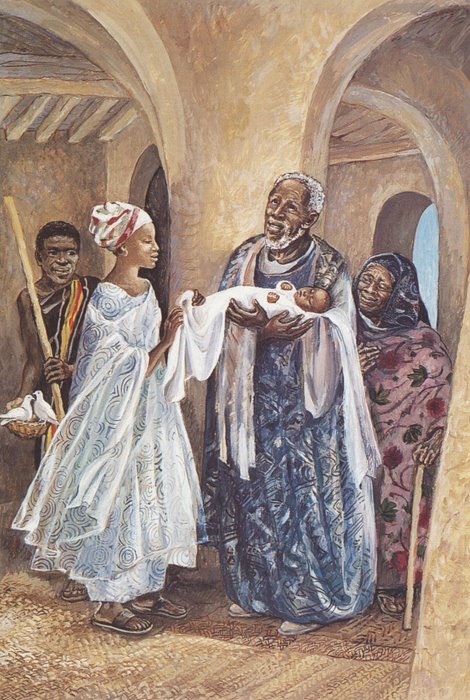
December 27, 2020
Revised Common Lectionary
Isaiah 61:10 – 62:3
Psalm 148
Galatians 4:4-7
Luke 2:22-40
Lectionary for Mass (RC)
Genesis 15:1-6; 21:1-3
Psalm 105:1-2, 3-4, 5-6, 8-9 (7a, 8a)
Hebrews 11:8, 11-12, 17-19
Luke 2:22 (23-38) 39-40
A few years before my mother died, she spent many hours poring over boxes of photos that she had collected over the years, including childhood pictures of my brother and me. She lovingly assembled an album for each of us that gives us as adults an opportunity to view some of the early events in our lives.
One of the photos that I treasure most dearly was taken on the day of my baptism, when I was just over a month old. When I look at my much younger self with my parents and godparents, I wonder what people were saying. I’m guessing that conversation mostly centered around the things people usually say about babies—how well I managed to get through the ceremony and perhaps some comments about how I looked. How different are the words we hear from Simeon in today’s Gospel as he encountered the newborn infant being presented at the Temple by Mary and Joseph!
There are, of course, some elements in today’s Gospel story and in Luke’s entire infancy narrative that speak to the ordinariness of the holy family. Mary and Joseph cared for their newborn—embracing the requirements of Jewish and Roman law, performing the expected rituals, traveling long distances together, finding shelter, returning home, and watching as the “child grew and became strong” (Lk 2:40). At the same time, the parents found themselves “amazed at what was being said about him” (2:33), suggesting that they could not at that moment understand the extraordinary events that would unfold in the life of their son.
Luke, of course, has no interest in reminiscing about Jesus’ early years or in providing biographical background information. The Gospel writer has instead included this story as the culmination of a well-constructed narrative that weaves together various pieces—birth announcements to both Zechariah and Mary, the visit of Mary to her cousin Elizabeth, the birth of John the Baptist, the birth of Jesus, the announcement to the shepherds, and the circumcision of Jesus. Taken together, these stories help us to understand who Jesus is and the mission for which he was sent by God.
Even though his own people would reject Jesus, Luke goes to great lengths to portray his family as faithful observant Jews, obedient to the Law, coming to the Temple to fulfill its commands. He deliberately frames the account of Jesus’ presentation in the Temple in such a way that Jewish readers would recall striking parallels to the story of Samuel and would connect Jesus with the long tradition that he represents.
Luke introduces us in this story to a “righteous and devout” (2:25) man named Simeon, who catches sight of the child and his parents in the Temple. The Gospel writer underlines the importance of Simeon’s words by mentioning not once, but three times, that he was guided by the Holy Spirit (Lk 2:25-27).
In the canticle that Simeon voices, he recognizes in this child the coming of God’s salvation both for Israel and for people of every nation: “a light of revelation to the Gentiles and for glory to your people Israel” (2:32). The song of Simeon expresses joy in a salvation that is not restricted, but rather is available to all people.
As Simeon blesses Mary and Joseph, his words hint at the rejection and opposition to which the ministry of Jesus would give rise, and which would ultimately lead him to the cross. His life would have great impact, destined as he was “for the falling and the rising of many in Israel” (2:34). He warns Mary that the impact would extend even to her: “a sword will pierce your own soul too” (2:35). No wonder they were amazed!
And so, as we sing our carols, even if in small groups or even in complete isolation, what is the good news for us and our families on this Sunday after Christmas? Today’s Gospel calls us first of all to rejoice that God’s salvation and power are often revealed among us in the ordinary, possibly in the people closest to us and even when we can be in contact only through Zoom. If we are paying attention, we can often see the amazing in the ordinary, just as Simeon did.
Today’s Gospel story also proclaims that while Jesus is one of us, he doesn’t belong to us. Even though he was a member of a particular family and was born into a particular nation, his life and mission were intended to usher in God’s salvation for all people. So too our families exist not just for themselves; they are to be communities that extend outward and express love through service of others. The Christian notion of family can never be restricted by blood, nationality, or race. Like the holy family, we are called to give witness to the amazing presence and working of God in the ordinary unfolding of our lives.
A Hymn for Today: “Now Let Your Servant”
Hymn writer Ruth Duck, FHS, has created a text that includes the Canticle of Simeon (Lk 2:29-32), Simeon’s words to Mary and Joseph (2:34-35), and a concluding stanza that voices the community’s praise for God’s faithful love. On this Sunday after Christmas, this text provides a compelling way to affirm Luke’s message about the identity and mission of Jesus in a spirit of sung praise. It is most often paired with DICKSON, a strong tune composed by African American composer Norah Duncan IV.
Now let your servant go in peace;
Let praise and blessing here increase;
For in our midst your word is done
And you have sent your Promised One.
Before the peoples you prepare
Your way of life which all may share.
You saving pow’r is now made known;
Among the nations love is shown.
Child, you are chosen as a sign
To test the human heart and mind;
For secrets hidden in the night
Shall be revealed in piercing light.
Now let us sing our Savior’s praise,
And tell God’s goodness all our days.
While breath is ours, let praise be heard
For God’s own faithful, saving word.
Text: Nunc dimittis, Luke 2:29-35; Ruth Duck, © 1992, GIA Publications, Inc. Used by permission.
Tunes: DICKSON, CONDITOR ALME SIDERUM, CANONBURY
Image Credit: Presentation of Jesus in the Temple, JESUS MAFA (Cameroon), 1973
 “Word and Song: A Lectionary Reflection” is written by the Executive Director of The Hymn Society, Rev. Dr. Mike McMahon. For his full bio, click here and scroll down to the “staff” section.
“Word and Song: A Lectionary Reflection” is written by the Executive Director of The Hymn Society, Rev. Dr. Mike McMahon. For his full bio, click here and scroll down to the “staff” section.
